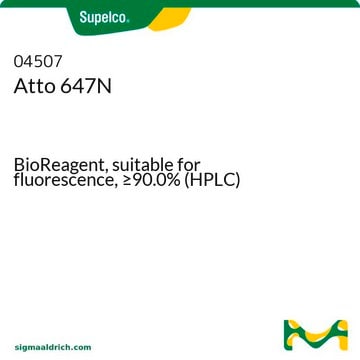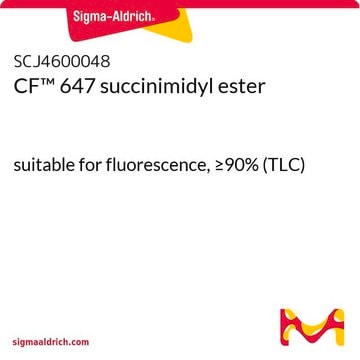28562
Atto 488 maleimide
BioReagent, suitable for fluorescence, ≥90% (HPLC)
Synonym(s):
Atto 488
Sign Into View Organizational & Contract Pricing
All Photos(1)
About This Item
Recommended Products
product line
BioReagent
Quality Level
Assay
≥90% (HPLC)
≥90% (degree of coupling )
manufacturer/tradename
ATTO-TEC GmbH
λ
in methanol: water (1:1) (with 0.1% perchloric acid)
UV absorption
λ: 501-506 nm Amax
suitability
suitable for fluorescence
storage temp.
−20°C
Related Categories
General description
Atto 488 Maleimide is a hydrophilic fluorescent label with high molecular absorption (90.000) and quantum yield (0.80). The fluorescence activity is excited at a maximum of 501nm, and the maximum emission is 523nm. Atto 488 Maleimide is optimized for argon laser excitation and characterized by high photostability. Hydrolysis of maleimides to a mixture of isomeric nonreactive maleamic acids can compete significantly with thiol modification, particularly above pH 8. Post coupling to a substrate, the label carries a net electrical charge of -1.
Application
Atto 488 Maleimide is used for labelling amines, which usually requires a higher pH than the reaction of maleimides with thiols. It is a well-suited fluorescent label for thiol groups.
Legal Information
This product is for Research use only. In case of intended commercialization, please contact the IP-holder (ATTO-TEC GmbH, Germany) for licensing.
Storage Class Code
11 - Combustible Solids
WGK
WGK 3
Flash Point(F)
Not applicable
Flash Point(C)
Not applicable
Personal Protective Equipment
dust mask type N95 (US), Eyeshields, Gloves
Certificates of Analysis (COA)
Search for Certificates of Analysis (COA) by entering the products Lot/Batch Number. Lot and Batch Numbers can be found on a product’s label following the words ‘Lot’ or ‘Batch’.
Already Own This Product?
Find documentation for the products that you have recently purchased in the Document Library.
Customers Also Viewed
Analysis of fluorescent nanostructures in biological systems by means of spectral position determination microscopy (SPDM).
Muller, P., et al. et al.
Current Microscopy Contributions to Advances in Science and Technology, 1, 3-12 (2012)
Mohd A Mohd Ridzuan et al.
PloS one, 7(3), e33845-e33845 (2012-04-06)
An actomyosin motor complex assembled below the parasite's plasma membrane drives erythrocyte invasion by Plasmodium falciparum merozoites. The complex is comprised of several proteins including myosin (MyoA), myosin tail domain interacting protein (MTIP) and glideosome associated proteins (GAP) 45 and
Tilak Jain et al.
Journal of structural biology, 179(1), 68-75 (2012-05-10)
Over the last three decades, Cryo-TEM has developed into a powerful technique for high-resolution imaging of biological macromolecules in their native vitrified state. However, the method for vitrifying specimens onto EM grids is essentially unchanged - application of ∼3 μL
Jonas K Hannestad et al.
ACS nano, 7(1), 308-315 (2012-12-12)
We use single-molecule fluorescence microscopy to monitor individual hybridization reactions between membrane-anchored DNA strands, occurring in nanofluidic lipid monolayer films deposited on Teflon AF substrates. The DNA molecules are labeled with different fluorescent dyes, which make it possible to simultaneously
Lucia De Rosa et al.
Organic & biomolecular chemistry, 10(2), 273-280 (2011-11-11)
In the last few years, the use of labeled proteins has significantly expanded in the life sciences. Now, labeled proteins are indispensable tools for a wide spectrum of biophysical and chemical biology applications. In particular, the quest for more sophisticated
Our team of scientists has experience in all areas of research including Life Science, Material Science, Chemical Synthesis, Chromatography, Analytical and many others.
Contact Technical Service




